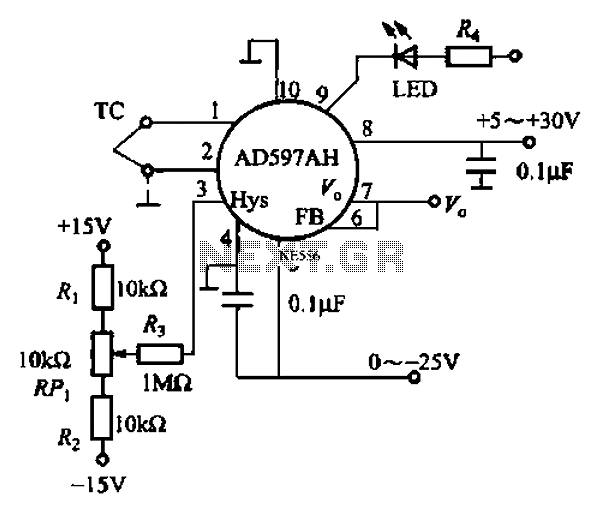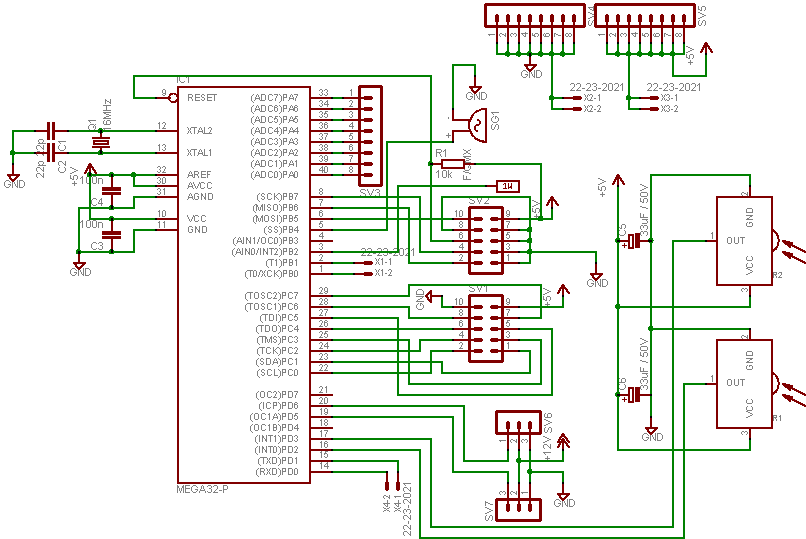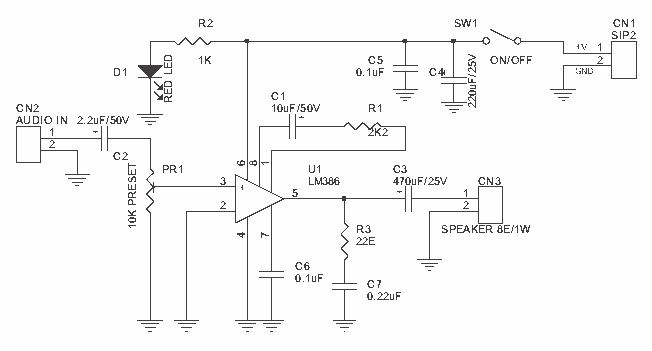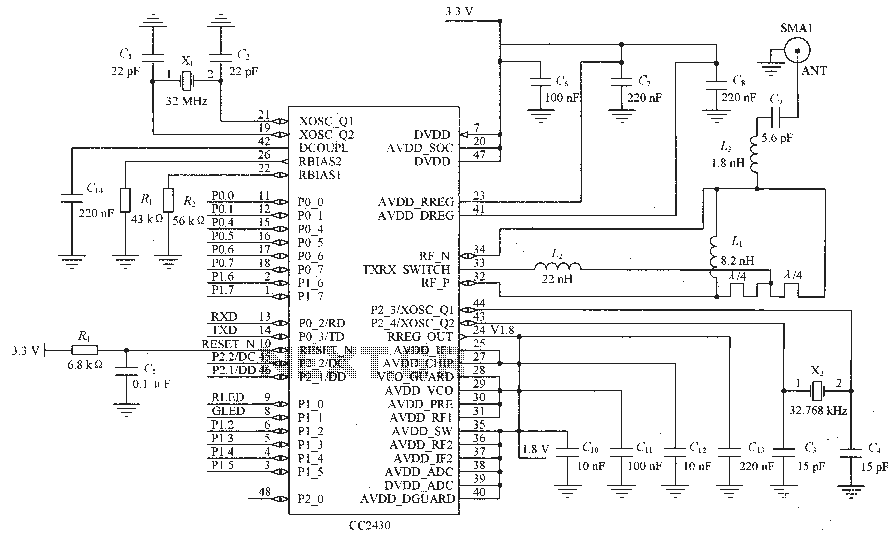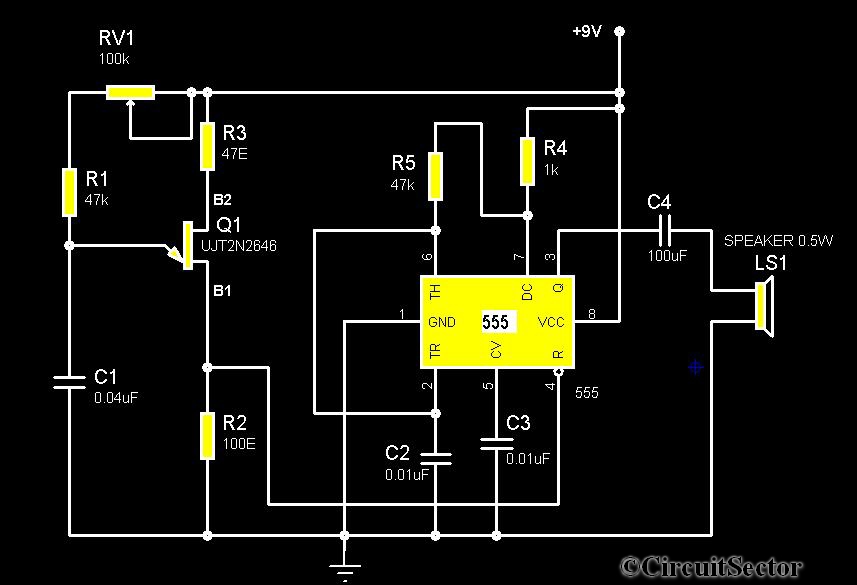
NE555 Basic Monostable
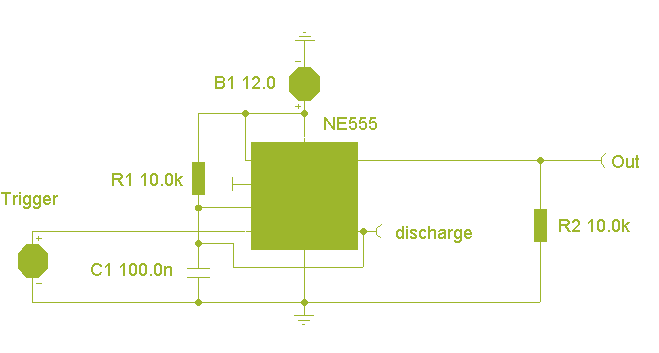
Here the popular 555 timing IC is wired as a monostable. The timing period is precise and equivalent to: 1.1 x R1 x C1. With component values shown this works out at approximately 1.1 msec. The output duration is independent of the input trigger pulse, and the output from the 555 is buffered and can directly interface to CMOS or TTL ICs, providing that the supply voltages match that of the logic family. More: The timing diagram above shows the output pulse duration, the trigger input, and the output at the discharge terminal of the IC.
The 555 timer IC is a versatile component widely used in various timing applications. In a monostable configuration, the 555 timer produces a single output pulse in response to a triggering event, making it suitable for applications such as pulse generation, timer circuits, and delay circuits.
In this configuration, the timing period (T) is determined by the resistor (R1) and capacitor (C1) values according to the formula T = 1.1 x R1 x C1. The output pulse width can be adjusted by changing the values of R1 and C1, allowing for precise control over the timing interval. For instance, if R1 is set to 10 kΩ and C1 to 100 nF, the output pulse duration would be approximately 1.1 milliseconds.
The output of the 555 timer in monostable mode is a buffered signal, capable of interfacing directly with CMOS or TTL logic families. This characteristic ensures compatibility with various digital circuits, provided that the supply voltage levels are consistent with the requirements of the connected logic devices.
The timing diagram associated with this configuration illustrates the relationship between the trigger input, the output pulse, and the discharge terminal of the IC. When a negative-going trigger pulse is applied to the trigger pin (pin 2), the output (pin 3) transitions high for the duration specified by the timing period. After this period elapses, the output returns to its low state, and the discharge pin (pin 7) is activated to discharge the timing capacitor, preparing the circuit for the next triggering event.
Overall, the monostable configuration of the 555 timer is a fundamental building block in electronic design, offering simplicity and reliability in generating precise timing signals.Here the popular 555 timing IC, is wired as a monostable. The timing period is precise and equivalent to:- 1.1 x R1 x C1 With component values shown this works out at approximately 1.1msec.The output duration is independant of the input trigger pulse, and the output from the 555 is buffered and can directly interface to CMOS or TTL IC`s, providing that the supply voltages match that of the logic family. The timing diagram above shows the output pulse duration, the trigger input and the output at the discharge terminal of the IC. 🔗 External reference
The 555 timer IC is a versatile component widely used in various timing applications. In a monostable configuration, the 555 timer produces a single output pulse in response to a triggering event, making it suitable for applications such as pulse generation, timer circuits, and delay circuits.
In this configuration, the timing period (T) is determined by the resistor (R1) and capacitor (C1) values according to the formula T = 1.1 x R1 x C1. The output pulse width can be adjusted by changing the values of R1 and C1, allowing for precise control over the timing interval. For instance, if R1 is set to 10 kΩ and C1 to 100 nF, the output pulse duration would be approximately 1.1 milliseconds.
The output of the 555 timer in monostable mode is a buffered signal, capable of interfacing directly with CMOS or TTL logic families. This characteristic ensures compatibility with various digital circuits, provided that the supply voltage levels are consistent with the requirements of the connected logic devices.
The timing diagram associated with this configuration illustrates the relationship between the trigger input, the output pulse, and the discharge terminal of the IC. When a negative-going trigger pulse is applied to the trigger pin (pin 2), the output (pin 3) transitions high for the duration specified by the timing period. After this period elapses, the output returns to its low state, and the discharge pin (pin 7) is activated to discharge the timing capacitor, preparing the circuit for the next triggering event.
Overall, the monostable configuration of the 555 timer is a fundamental building block in electronic design, offering simplicity and reliability in generating precise timing signals.Here the popular 555 timing IC, is wired as a monostable. The timing period is precise and equivalent to:- 1.1 x R1 x C1 With component values shown this works out at approximately 1.1msec.The output duration is independant of the input trigger pulse, and the output from the 555 is buffered and can directly interface to CMOS or TTL IC`s, providing that the supply voltages match that of the logic family. The timing diagram above shows the output pulse duration, the trigger input and the output at the discharge terminal of the IC. 🔗 External reference
Warning: include(partials/cookie-banner.php): Failed to open stream: Permission denied in /var/www/html/nextgr/view-circuit.php on line 713
Warning: include(): Failed opening 'partials/cookie-banner.php' for inclusion (include_path='.:/usr/share/php') in /var/www/html/nextgr/view-circuit.php on line 713
